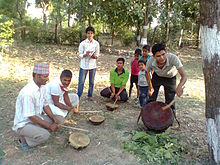दमाइँ | |
|---|---|
 Damai men playing traditional Damaha | |
| Regions with significant populations | |
| 565,932 (1.9% of Nepal's population) (2021) [1] | |
| Languages | |
| Kalautya Rudika (Damai kura)Nepali (Khas kura) | |
| Religion | |
| Shamanism, Buddhism, Hinduism 96.59% (2011), Christianity 3.22% (2011) [2] | |
| Related ethnic groups | |
| Khas people, Kami, Badi, Sarki, Gandarbha/Gaine | |
Damai (Nepali : दमाइँpronounced [dʌmaĩ] ; IAST: Damāĩ) is an occupational caste found among Khas people comprising 45 subgroups. [3] Their surnames take after the subgroup they belong to. [4] People belonging to this caste are traditionally tailors [3] and musicians capable of using the naumati baja - an ensemble of nine traditional musical instruments. [4] The term Damai is coined from the musical instrument Damaha. The 1854 Nepalese Muluki Ain (Legal Code) categorized Damai as "Lower caste” category. [5]
Contents
The Government of Nepal abolished the caste-system and criminalized any caste-based discrimination, including "untouchability" in 1963. [6] The country, previously ruled by a Hindu monarchy was a Hindu nation which has now become a secular state. [7] It was declared a republic in 2008, [8] thereby ending it as the Hindu kingdom with its caste-based discriminations and the untouchability roots. [9]
According to the 2021 Nepal census, Damai make up 1.94% of Nepal's population (or 565,932 people). [10] Damai are categorized under "Hill Dalit" among the 9 broad social groups, along with Kami, Badi, Sarki and Gaine by the Government of Nepal. [11]